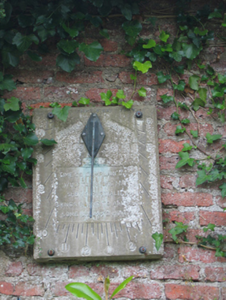Survey Data
Reg No
40828012
Rating
Regional
Categories of Special Interest
Scientific, Technical
Original Use
Sundial
In Use As
Sundial
Date
1930 - 1940
Coordinates
237163, 411972
Date Recorded
08/02/2013
Date Updated
--/--/--
Description
Collection of sundials associated with Dunmore House, erected c. 1935-6. Sundial located to the centre of the walled garden (see 40828005) comprising concrete sundial with metal gnomon and inlaid metal numbers set on a concrete column. Sundial built into the brick lined wall to the north boundary of walled garden (see 40828005) comprising concrete face with metal gnomon and inlaid metal numbers set on a concrete column, and with raised text to centre and to head. Concrete plaque built into north wall of walled garden with inlaid mathematical graph of path of sun. Sundial located to the south of Dunmore House (see 40828003) comprising concrete sundial with metal gnomon and inlaid metal numbers set on a concrete column. Located within grounds of Dunmore House, and to the north-east of Carrigans.
Appraisal
This quirky collection of early-to-mid twentieth century sundials creates interesting and curious features within the grounds of Dunmore House (see 40828003). A number are located within the walled garden (see 40828005) with another example sited to the south of the front elevation of the house. The sun dials were created as experiments by Mrs. McClintock, a noted mathematician, who lived at Dunmore during the first half of the twentieth century. The reinforced concrete shafts and faces are the work of Col. McClintock, her husband, who was an army engineer and experimented with reinforced concrete. Sadly this husband and wife later passed away in a tragedy. Sundials are a feature that were frequently erected in county estates during the eighteenth and nineteenth centuries but twentieth century examples are rare, particularly examples with quirky origins such as this collection at Dunmore House. This curious collection is an interesting addition to the built heritage of the local area, and forms part of a group of structures associated with Dunmore House.





